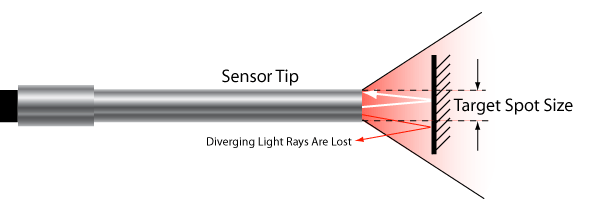Q. What is the maximum range of the sensor?
A. 75 mm (3″). The maximum operating range can be extended to 150 mm or more if retro-reflective tape is applied to the target surface.
Q. What is the frequency response?
A. DC – 20 KHz is standard. Speeds up to and exceeding 1 megahertz are optional.
Q. What is the resolution?
A. These are highly sensitive devices. Resolution is dependent upon the sensor model and bandwidth, and vary from about 10 µm down to 2 nanometers. See our Product Data Sheets for each model.
Q. How does the sensor work?
A. These are retro-reflective type devices that measure the intensity of light reflected back from a target surface.
Q. Is the sensor safe to look at?
A. LED’s are the light sources. The emitted light is not focused nor collimated as with lasers. Instead, the light coupled into many transmit fibers that are distributed in the sensor tip. Light emits from the tips in a conical shape with decaying intensity at increasing distance. Therefore, there is no safety issue with the human eye.
Q. What exactly is included in the price of the sensor? Do I need any additional equipment to use it?
A. The price includes the entire sensor system: fiberoptics, electronics and operating software with digital sensors. AC/DC power adaptors are provided with some units, others require user supplied DC power.
Q. How quickly can you deliver the sensor?
A. 2 weeks for standard units. 6-8 weeks for custom models.
Q. What is the target spot size?
A. The target spot size = the area of the fiberoptics in the sensor tip. The smallest diameter probe we offer is the model model D6: 0.006 inch diameter (Ø 0.15 mm)

Q. How can I get the best accuracy?
A. A smooth and highly reflective target gives the best results. Rough surfaces scatter light rays, thereby decreasing the sensor’s repeatability and accuracy.
Q. Is a mirrored target surface required?
A. No. Any target that reflects light can be measured; for example, anodized aluminum, fiberglass rotors, paper, glass, etc.
Q. What is the allowable angle for sensor mounting? (perpendicularity to the target).
A. These devices are very sensitive to tilt. We recommend they be installed with very good perpendicularity to the target: ± 0.5°
Q. What is the effectiveness of the sensor exposed to ambient light?
A. These devices operate with continuous light emission. Standard units are subject to ambient lighting pickup. In environments where background light is a problem, Ambient Light Rejection can be included by specifying Option R1. With Option R1, the sensor operates at 850 ±12 nm.
Q. Is it possible to use these sensors in a liquid?
A. Yes, but the output response is different than in air. The sensor should be calibrated while submerged in the fluid it will be used with. The factory can provide calibrations in fluids if a 4 oz. sample is provided.
Q. What are the temperature ranges of the sensor?
A. Sensor tips and fiber optic cables can be fabricated to operate from cryogenic temperatures to 450°C using the appropriate sheathing materials and glass fibers. Quartz fibers can be used to extend the range of operation up to 800°C.
Q. Is the light visible or not?
A. Our primary wavelength is at 850 nanometers, in the near infra-red zone. It is only barely visible in darkness.Q. Are these sensors vacuum compatible?
A. Yes. We provide vacuum passthru hardware allowing for operation in vacuum environments from low to ultra-high vacuum.Q. Can these sensors perform in high magnetic fields?
A. Yes. We can build the sensor tips and fiberoptic cables using non-magnetic materials.
Q. Does radiation effect sensor performance?
A. Yes. Glass fibers will darken with very low doses of radiation. Quartz fibers are radiation resistant and can be used to 108 rads.Q. What is the Standoff Distance? Is this a minimum required gap?
A. Standoff distance is given as a reference point the customer to know what operating gap puts the sensor at its best point of operation – the ‘The Sweet Spot.’ it is not a required distance nor is it a minimum gap requirement.
Q. Are these sensors intrinsically safe?
A. The sensor tips and fiber optic cables are ‘intrinsically safe’. They do not have any current or voltage applied to them. The sensor electronics must be mounted by the customer in an explosion-proof enclosure to make the entire system intrinsically safe.
Q. How easy/difficult is the sensor to operate?
A. The sensors are very easy to operate, especially the RC models. Simply apply DC power, set the gap and take measurements. D models require a calibration step to adjust the sensor output for the reflectivity of the target to be measured.
Q. How Long Can The Fiber Optic Cable Be?
A. Up to 15 m without a in-line connector. Longer if connectorized.
Q. How Does the RC Sensor Work?
A. The RC type sensor is actually two D type sensors mounted side-by-side in the sensor tip. The ratio of the two sensor outputs is processed to generate the Reflectance Compensated function.
Q. Other than the ability to measure the start of motion, are there any other advantages of measuring acceleration using a non contact fiber optic displacement sensor?
A. Yes. Due to the sensors being non-contact, there is no distortion of the test system characteristics. Traditional vibration sensors add mass/inertia that result from the mounting/connection and their associated probes and wires. Non-contact sensors are especially advantageous for items that have very small mass or high rate of movements. In addition, due to the non-contact nature of sensing displacement, there is no increase in error as the natural resonance of the sensor is approached by the motion of the device under test.
